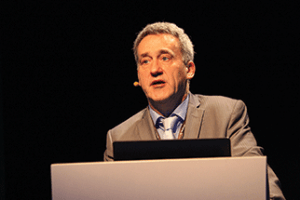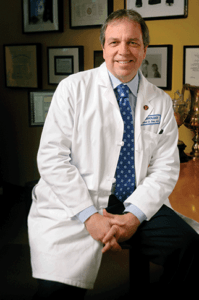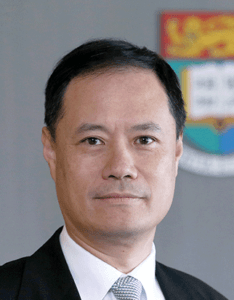
Rodney White
This year’s annual China Endovascular Course (CEC; 2–5 November, Beijing, China) played host to the first CX@CEC session, in collaboration with the Charing Cross Symposium. Focused on complex aortic disease, this session featured a selection of international and Chinese experts sharing their experiences and giving advice on how to approach a variety of challenging aortic arch pathologies.
D iscussing ascending aortic remodelling for a variety of pathologies, Rodney White (Long Beach Memorial Heart and Vascular Institute, Long Beach, USA) took delegates through the lessons he has taken from performing thoracic endovascular aortic repair (TEVAR) in that segment.
White detailed his experience investigating the Valiant thoracic endograft (Medtronic) as part of the PSIDE (Physician-sponsored investigational device exemption) feasibility study, of which White was a co-principal investigator. The study enrolled patients with type A thoracic aortic dissection, retrograde type A thoracic aortic dissection, intramural haematoma, penetrating ulcer or pseudoaneurysm of the ascending thoracic aorta affecting the area between the sinus of Valsalva and the innominate artery orifice (with no involvement of the aortic valve). The patients included had proximal and distal landing zones of at least 1cm in the ascending aorta, with aortas between 28mm and 44mm in diameter. All patients were deemed high-risk surgical candidates and were in the American Society of Anesthesiologists class IV. All procedures were performed in a hybrid OR.
White said that the Valiant endograft offered “durable treatment of lesions of the thoracic aortas with tubular, non-aneurysmal aortic anatomy.” He told the audience that their study demonstrated “accurate deployment, secure fixation, and no migration.”
He also cautioned that a tortuous ascending aorta can “lead to underestimation of the length required for complete coverage of the outer wall. As such, the transapical approach is being considered as a better alternative to ‘horizontal heart’ configurations.”
One of the most important pieces of advice White offered was that “a hybrid room design and transaortic valve replacement set-up is essential for good ascending aortic endograft performance.” Good outcomes also require the input of a multidisciplinary team of specialists which consists “of the expertise needed to fully address potential complications, ranging from cardiac perforation to coronary occlusion.”
White’s third piece of advice was that bail-out procedures for catastrophic ascending aortic events—such as valve entrapment and coronary artery occlusion—must be established and reinforced in order to prevent adverse events.

Frank Vermassen
Frank Vermassen (Ghent University Hospital, Ghent, Belgium) addressed when and how to treat type B aortic dissection, suggesting that TEVAR is effective in the acute treatment of the majority of such cases. He noted that, if the decision is taken to treat uncomplicated type B dissection, it is best done in the subacute phase.
Vermassen explained that type B dissection—whether complicated or uncomplicated—can be classified as acute (less than two weeks), subacute (from two weeks to three months) or chronic (more than three months).
Uncomplicated type B dissection can be treated with medical therapy. However, the aortic wall remains weakened in these cases and there is a risk of aneurysm formation, Vermassen said.
The INSTEAD trial compared medical and endovascular treatment for type B aortic dissections in 140 patients. Two-year survival for the medical treatment arm was 95.6% compared with 88.9% for the endovascular plus medical therapy group. The rate of false lumen thrombosis for the medical therapy patients was 19.4% compared with 91.3% for the endovascular group. The INSTEAD XL trial looked at patient outcomes after two years, and found that in 30% of cases the disease continued to progress following TEVAR. Vermassen also noted that survival benefit was similar for both groups.
The ADSORB trial also explored the different outcomes of medical treatment and endovascular repair. The trial followed 61 patients assigned to either best medical treatment alone or best medical treatment with endografting. The trial found far lower false lumen thrombosis for best medical treatment alone (3% vs. 57%). There was no difference between the two groups in aortic diameter, and an equal number (14/30 for best medical treatment and 11/31 for best medical treatment with endograft) had aortic dilation. There was no difference in survival between the two groups.
As for when to treat, acute phase treatment can result in complications, with coverage of the left subclavian artery—recorded in 64% of ABSORB patients—risking paraplegia, stroke and peripheral nerve damage. Treatment in this phase can also cause type A dissection, Vermassen added.
Aneurysm formation following a TEVAR procedure is also a concern. Risk factors for aneurysm formation include an aortic diameter >40mm, a perfused false lumen, and entry tears in the proximal aorta. Indeed, stent graft-induced tears are a source of entry tears, their incidence reported as up to 3.2% in non-Marfan patients and 33.3% in Marfan patients. Such tears are associated with mortality reported at up to 28.6%.
Risk factors for late complications include an initial false lumen diameter >22mm, a partially thrombosed false lumen, entry tears in the proximal descending thoracic aorta (especially at the aortic concavity), large entry tears, and multiple entry tears. Vermassen also warned that insufficient best medical treatment can actually increase the risk of late complications.
Whether longer stent grafts are more effective is still an open debate, Vermassen told the audience. While such stent grafts are more effective in inducing false lumen thrombosis, they are associated with entry tears at the coeliac trunk level. Furthermore, the risk of spinal cord ischaemia increases when a graft is longer than 20cm.
The Petticoat concept has been developed to try to address some of these issues, with a stent graft used to cover the proximal entry tear and then a bare stent below. This allows the expansion of the true lumen alongside the stabilisation of the intimal membrane. Other options for distal occlusion of the false lumen include the Knickerbocker technique and the Candy plug technique.
Summarising his presentation, Vermassen said, “TEVAR is effective in the acute treatment of the majority of complicated type B dissections. If the decision is taken to treat uncomplicated type B aortic dissection, this is best done in the subacute phase. Although TEVAR decreases the false lumen and increases the true lumen, it does not prevent disease progression in all patients. The evolution of the uncovered part of the aorta remains a concern in the long term, and the value of adjunctive techniques to prevent late progression remains to be investigated.”

Michael Dake
Michael Dake (Stanford University School of Medicine, Stanford, USA) discussed the long-term feasibility of single-branched endografting in aortic arch zones 0, 1 and 2.
Dake specifically discussed the initial studies of the TAG thoracic branch endoprosthesis (Gore). The TAG is a modular device, constructed of off-the-shelf components with the inner lumen used for anchoring and sealing the branch component. It is an integrated system with aortic and branch components designed for use in the arch, and accompanying accessory devices to facilitate delivery. The first human implant of the device was in January 2014.
Feasibility studies analysing the use of the device in zones 0, 1 and 2 have been planned. The zone 2 feasibility study will enrol 20–40 patients, while the zone 0/1 early feasibility study will enrol up to 20. Patients in the zone 0/1 trial must be at high-risk for conventional open repair. The primary endpoints for both studies will be successful access and deployment and primary patency of the side branch.
Thus far, the zone 2 study has enrolled 31 patients (16 male, 15 female) with a mean age of 74.1 years. The mean treated aneurysm diameter was 54.8mm and the mean total treated length was 17.3cm.
The zone 0/1 study has follow-up data for nine patients (seven male, two female) with a mean age of 72.8 years. The mean treated aneurysm diameter was 62mm and the mean total treated length was 19.7cm.
So far, both trials have achieved 100% technical success and 100% one-month survival. The peri-procedural stroke rate for the zone 2 patients is 3.3% (n=1) and 22.2% (n=2) for the zone 0/1 patients. There was no loss of side branch patency for the zone 0 patients, with a 3.3% loss of patency for zone 2 patients.
There were four type II endoleaks and one type III endoleak at one month for the zone 2 patients, although there was no reported aneurysm enlargement for these patients. There was one type II endoleak at 12 months in zone 0/1 patients, with no reported aneurysm enlargement. There was no device- or procedure-related all-cause mortality in either study.
With regards to stroke risk, Dake said that based on these initial studies, “Risk estimates vary between a relatively low 3.3% (zone 2) to a very high 22.2% (zones 0/1). This is compared with 7.4% for non-branched TEVAR in the proximal descending thoracic aorta. By extension from non-branched graft literature, we believe that groups with an increased risk are the elderly, those with prior stroke (especially high—up to 28%), high-grade arch atheroma and mobile atheroma.”
Dake said that a pivotal trial is now underway for the TAG device, with the first implant completed in September 2016. The trial will study aortic arch aneurysms requiring placement of the proximal extent of the aortic stent graft in zone 0, 1 or 2 at up to 40 sites with a minimum of 175 and maximum of 435 patients enrolled, who will be followed out to five years.

Stephen Cheng
Stephen Cheng (University of Hong Kong, Hong Kong) presented on the treatment of aortic arch pathologies using endovascular double- and triple-branched stent graft designs. He discussed the evolution of endovascular options in the aortic arch from chimneys, scallops and fenestrations to single, double, and triple branched designs. He outlined the basic operating principles and technical challenges in landing in the ascending aorta, including access limitations, tortuosity, accurate placement and blood pressure control with rapid cardiac pacing or IVC occlusion balloons. While there are currently two commercial inner branched stent grafts for the arch, worldwide experience is limited to 100-250 cases and the stroke risk is still significant and can amount to 15-20%. He recommended that when treating the aortic arch, operators avoid thrombus and very large aneurysms, stage their procedures, avoid marginal access, avoid manipulations in the arch, and use a direct carotid approach when possible.







